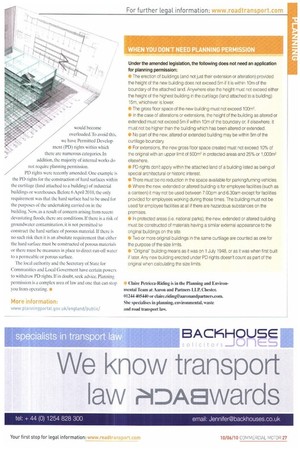I Look before LEGAL DIGEST
Page 26

Page 27

If you've noticed an error in this article please click here to report it so we can fix it.
you leap
Planning permission is not always needed for changes to an operating centre, but operators should always take advice first.
Words: Claire Petricca-Riding Applications for operating centres or variations to existing ones face an increased level of objections, mostly from local authorities and residents, complaining about nuisance issues such as noise and dust. This leads to the local authority investigating the operation in terms of planning control and statutory nuisance. Complaints received by the Traffic Commissioner lead to complications at operators' flye-year review.
Operators should always seek professional advice before undertaking any development work. This can either be from a planning solicitor or a planning consultant. The Royal Town Planning Institute can help find a consultant in your area: http://www.ripi.org.iik/
Obtaining Planning Permission
As part of the application you will need to till in an application form, draw up plans that detail the development and its location, and submit a design and access statement. This document tells the local authority why you want the development, how it is going to he done and which planning policies from the local development plan support the application. The fee varies depending on the size of the development. For material change of use.
applications fees are
usually around £330.
Once the application is validated, the local authority has a minimum of eight weeks to make a decision. Once validated, the local authority will consult on it, sending details of the application to local residents and businesses, parish councils and other local authority departments such as highways. The consultation period lasts 21 days and if no objections are received the application and it has officer support, the application usually proceeds on a delegated basis allowing the planning officer to make the decision.
If there are objections. this increases the chance of the application being decided by a planning committee at an open meeting of local councillors. The planning officer will introduce your application to the committee: the councillors read a short report drafted by the planning officer, which either recommends approval or rejection. You can speak in support. and objectors can air their grievances. The councillors then vote on the application — a majority is needed to approve it.This is often seen as a risky way of obtaining planning permission as neither you nor the local authority has any control over the decision of the committee. If the application goes to committee, it is worth getting to know your local councillor very well.
If you have been operating or constructed a building without obtaining planning permission, you may be able to make an application called the Certificate of Lawfulness for Exiting Use or Development (CLEUD). If you have been operating for more than 10 years or the building has been erected for more than four years, you can apply to the local authority to obtain approval in retrospect, by way of statutory declaration. It is a complicated process and you should seek legal advice before proceeding.
If an application is refused, you have the right of appeal to the Planning Inspectorate.
Making minor changes
If every extension, minor addition or alteration to a building required a planning application, the system
would become overloaded. To avoid this.
we have Permitted Develop ment (PD) rights within which there are numerous categories. In addition, the majority of internal works do not require planning permission.
PD rights were recently amended. One example is the PD rights for the construction of hard surfaces within the curtilage (land attached to a building) of industrial buildings or warehouses. Before 6 April 2010, the only requirement was that the hard surface had to be used for the purposes of the undertaking carried on in the building. Now, as a result of concern arising from recent devastating floods, there are conditions. If there is a risk of groundwater contamination. it is not permitted to construct the hard surface of porous material. If there is no such risk then it is an absolute requirement that either the hard surface must he constructed of porous materials or there must be measures in place to direct run-off water to a permeable or porous surface.
The local authority and the Secretary of State for Communities and Local Goverment have certain powers to withdraw PD rights. If in doubt, seek advice. Planning permission is a complex area of law and one that can stop you from operating. s More information:
www.planningportallov.uldengland/public/




























































































































